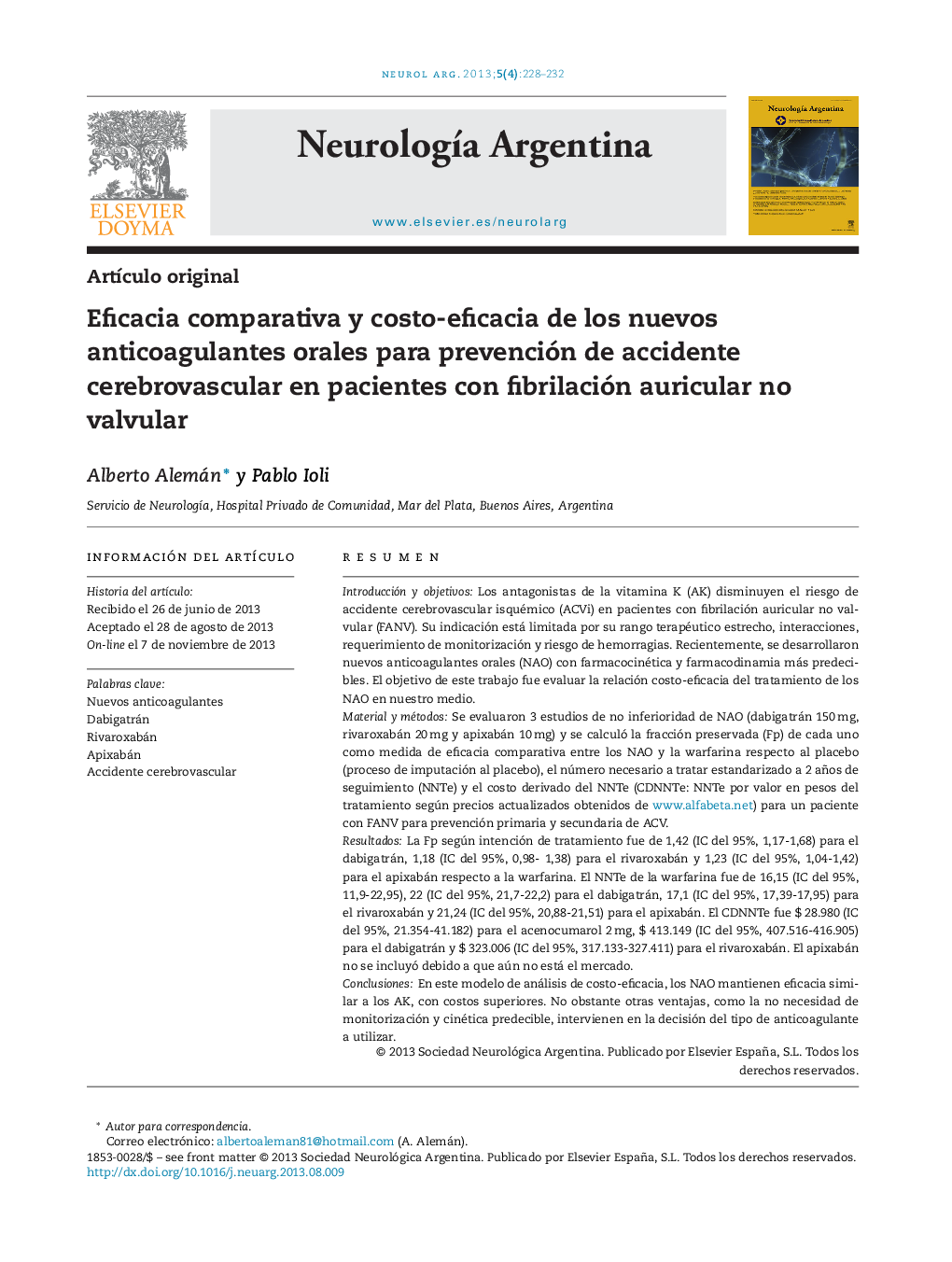| Article ID | Journal | Published Year | Pages | File Type |
|---|---|---|---|---|
| 3076570 | Neurología Argentina | 2013 | 5 Pages |
ResumenIntroducción y objetivosLos antagonistas de la vitamina K (AK) disminuyen el riesgo de accidente cerebrovascular isquémico (ACVi) en pacientes con fibrilación auricular no valvular (FANV). Su indicación está limitada por su rango terapéutico estrecho, interacciones, requerimiento de monitorización y riesgo de hemorragias. Recientemente, se desarrollaron nuevos anticoagulantes orales (NAO) con farmacocinética y farmacodinamia más predecibles. El objetivo de este trabajo fue evaluar la relación costo-eficacia del tratamiento de los NAO en nuestro medio.Material y métodosSe evaluaron 3 estudios de no inferioridad de NAO (dabigatrán 150 mg, rivaroxabán 20 mg y apixabán 10 mg) y se calculó la fracción preservada (Fp) de cada uno como medida de eficacia comparativa entre los NAO y la warfarina respecto al placebo (proceso de imputación al placebo), el número necesario a tratar estandarizado a 2 años de seguimiento (NNTe) y el costo derivado del NNTe (CDNNTe: NNTe por valor en pesos del tratamiento según precios actualizados obtenidos de www.alfabeta.net) para un paciente con FANV para prevención primaria y secundaria de ACV.ResultadosLa Fp según intención de tratamiento fue de 1,42 (IC del 95%, 1,17-1,68) para el dabigatrán, 1,18 (IC del 95%, 0,98- 1,38) para el rivaroxabán y 1,23 (IC del 95%, 1,04-1,42) para el apixabán respecto a la warfarina. El NNTe de la warfarina fue de 16,15 (IC del 95%, 11,9-22,95), 22 (IC del 95%, 21,7-22,2) para el dabigatrán, 17,1 (IC del 95%, 17,39-17,95) para el rivaroxabán y 21,24 (IC del 95%, 20,88-21,51) para el apixabán. El CDNNTe fue $ 28.980 (IC del 95%, 21.354-41.182) para el acenocumarol 2 mg, $ 413.149 (IC del 95%, 407.516-416.905) para el dabigatrán y $ 323.006 (IC del 95%, 317.133-327.411) para el rivaroxabán. El apixabán no se incluyó debido a que aún no está el mercado.ConclusionesEn este modelo de análisis de costo-eficacia, los NAO mantienen eficacia similar a los AK, con costos superiores. No obstante otras ventajas, como la no necesidad de monitorización y cinética predecible, intervienen en la decisión del tipo de anticoagulante a utilizar.
Introduction and objectivesThe vitamin K antagonists (VKA) reduce the risk of ischemic stroke in patients with non-valvular atrial fibrillation (NFAV). Indication of the VKA, is limited by its narrow therapeutic range, interactions, monitoring requirements and risk of haemorrhagic events. Recently developed new oral anticoagulants (NOA) with more predictable pharmacokinetics and pharmacodynamics. The aim of this study was to evaluate the cost-effectiveness of NOA in Argentina.Material and methodsWe evaluated three non-inferiority studies (dabigatran, rivaroxaban and apixaban) and calculated the preserved fraction (Pf) of each as comparative efficacy measure between NOA and warfarin over placebo, the standardized number needed to treat at 2 years of follow up (sNNT) and derivative cost from sNNT (sNNTDC:sNNT x treatment value obtained from www.alfabeta.net updated prices) for a patient with NVAF for primary and secondary prevention of stroke.ResultsThe Pf by intention to treat was 1.42(95%CI:1.17-1.68) for dabigatran, 1.18(95%CI0.98-1.38) for rivaroxaban and 1,23(95%CI:1.04-1.42) for apixaban compared to warfarin. The sNNT of warfarin was 16.15(95%CI:11.9-22.95), 22(95%CI:21.7-22.2) for dabigatran, 17.1(95%CI:17.39-17.95) for rivaroxaban and 21.24(95%CI:20.88-21.51) for apixaban. The sNNTDC was $ 28,980 (95%CI: 21,354-41,182) for acenocoumarol, $ 413,149(95%IC: 407,516-416,905) for dabigatran and $ 323,006(95%IC: 317,133-327,411) for rivaroxaban. The apixaban was not included because it is not yet commercially.ConclusionsIn this model of cost-effectiveness analysis the NOA maintain similar efficacy to VKA with higher costs. However other advantages such as no need for monitoring and predictable kinetics involved in the decision on the type of anticoagulant used.
